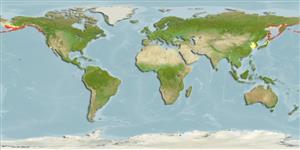Common names from other countries
>
Perciformes/Zoarcoidei (Eelpouts and pricklebacks) >
Stichaeidae (Pricklebacks) > Alectriinae
Etymology: Alectrias: Greek, alektros, -os, -on = single, married in illegal or unhappy marriage (Ref. 45335).
More on author: Pallas.
Environment: milieu / climate zone / depth range / distribution range
Ecologia
marinhas demersal; intervalo de profundidade 0 - 100 m (Ref. 50550), usually ? - 50 m (Ref. 51666). Temperate
Northwest Pacific: Commander Islands and southeastern Kamchatka to the Sea of Okhotsk and northern Sea of Japan. Northeast Pacific: Alaska.
Tamanho / Peso / Idade
Maturity: Lm ? range ? - ? cm
Max length : 10.0 cm SL macho/indeterminado; (Ref. 43239)
Descrição breve
Chaves de identificação | Morfologia | Morfometria
Espinhos dorsais (total) : 59 - 66; Raios dorsais moles (total) : 0; Espinhos anais: 1; Raios anais moles: 41 - 45; Vértebras: 64 - 70. Gray to nearly black to bright spotted with patterns; usually a wavy line extending along back, separating dark portion from lighter spots that continue onto dorsal fin (Ref. 43939). Caudal fin rounded.
Mainly intertidal, but may be found at depths as much as 100 m (Ref. 43939); typically found shallower than 50 meters (Ref. 51666). Often in bays with pebble-rock debris bottoms (Ref. 43939). Oviparous, eggs are guarded by the female parent (Ref. 58332).
Life cycle and mating behavior
Maturities | Reprodução | Spawnings | Egg(s) | Fecundities | Larvas
Mecklenburg, C.W., T.A. Mecklenburg and L.K. Thorsteinson, 2002. Fishes of Alaska. American Fisheries Society, Bethesda, Maryland. xxxvii +1037 p. (Ref. 43939)
Categoria na Lista Vermelha da IUCN (Ref. 130435)
CITES (Ref. 128078)
Not Evaluated
Ameaça para o homem
Harmless
Utilização humana
Ferramentas
Relatórios especiais
Descarregue XML
Fontes da internet
Estimates based on models
Preferred temperature (Ref.
115969): 2.3 - 12.9, mean 6 (based on 248 cells).
Phylogenetic diversity index (Ref.
82804): PD
50 = 0.5156 [Uniqueness, from 0.5 = low to 2.0 = high].
Bayesian length-weight: a=0.01000 (0.00244 - 0.04107), b=3.04 (2.81 - 3.27), in cm Total Length, based on all LWR estimates for this body shape (Ref.
93245).
Nível Trófico (Ref.
69278): 3.1 ±0.44 se; based on food items.
Resiliência (Ref.
120179): Médio, tempo mínimo de duplicação da população 1,4 - 4,4 anos (Preliminary K or Fecundity.).
Fishing Vulnerability (Ref.
59153): Low vulnerability (10 of 100).
